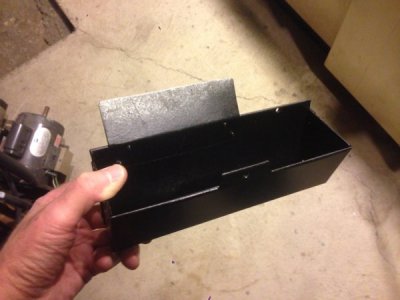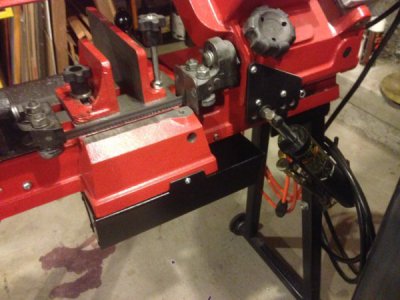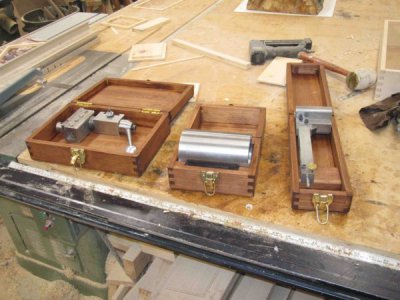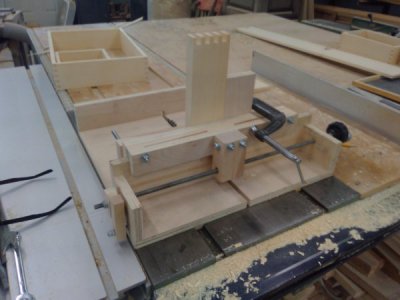POTD was installing an 8” set-tru style chuck on my Grizzly G0709 14” x 40” lathe. The G0709 comes with a 6” 3-jaw and a 10” 4-jaw. I’ve always thought the 6” chuck looked a little small. Plus, I had a project turning a 6” or 7” piece of material which wouldn’t fit in the 3-jaw chuck. So, sold some stuff on eBay and bought an 8” chuck from CME Tools out of Madison Heights, MI for $220 delivered, and an 8” D1-5 backing plate from CDCOtools.com for around $80 delivered.
OK, had some pucker factor when I opened the boxes. The 8” plate from CDCO Tools is really 200 mm or about 7 7/8”. The chuck is 210 mm diameter with a mounting bolt circle of 7 ½”. The bolts are 10mm or about 3/8” inch which makes the outside edge of the threads at 7 7/8” . . . I decided to chance the threads poking through the edge of the plate and proceeded.
Mounted the adapter plate to the lathe and started turning away. The chuck register is 120 mm diameter or about 4.724”. I turned down to 4.723” and set the chuck in place. By the way, the backing plate is cast iron which turns very easily, but makes a big mess! I turned the register to a relatively tight fit so the chuck would be centered for transferring the 3 mounting bolt holes to the backing plate.
Clamped the chuck on the plate and transferred the 3 holes. Then removed the chuck and took another 0.015” off the backing plate register. That should give me 0.008” of radial adjustment.
Took the backing plate to the mill and found the transfer punched holes with an SDA laser center finder. Could be my mill/collets, but my SDA needs to be trued every time. I went through the 3 holes by changing the set up on each one, so trued the laser 3 times. Fortunately the process only takes about a minute. Spot drilled, tap drilled and tapped the 3 mounting holes. I cheated the holes about 0.002” toward the center because of the bolt circle being the same as the OD of the backing plate. The chuck holes are about 11.4 mm diameter so there’s 0.7 mm or close to 0.030” clearance between the bolts and the chuck.
Screwed the chuck to the backing plate and mounted it on the lathe. Adjusted the 4 adjusting screws with the 3 chuck mounting bolts just off snug. Used a piece of 2” drill rod for my initial set up bar. The centering process is much like setting up a 4-jaw chuck; zero a dial indicator (0.0001” resolution in my case) with an adjusting screw flat to the world. Then turn the chuck 180 deg. and note the needle movement. Use two Allen wrenches to adjust the opposite side adjusting screws until the needle moved half of the range. Then did a cursory 180 rotation to verify adjustment. Turn the chuck 90 deg. and repeat.
I then mounted a 1” piece of drill rod and let 18” hang out of the chuck. Checked radial runout at the chuck at about 0.0004”; pretty good! Then moved a foot down the rod and repeated. Had about 0.0008” runout there. The chuck is advertised as having adjustments for lateral runout too. Frankly, I didn’t check how it is done, but it looks like the three screws on the center ring provide the adjustment. I hope to never have to find out as that adjustment appears to require taking the chuck off the backing plate for each “tweak”. At 0.0004” addition radial runout 12” from the chuck, I’m calling it good enough!
So how did it all work out? Pretty happy with the $300 set-tru style chuck. It uses a different sized chuck key than the stock 6” chuck (which serves dual purpose for turning the chuck cams), so I’ll need to add a hole to the lathe’s tool rack. Oh, might have to look at the belt tension on the lathe also. Lots more mass at start up, so the motor belts have a little “chirp” when spinning the chuck up to speed. Might need to look at a 3-phase motor and a VFD someday for a slower start up.
Bruce
View attachment 241411 View attachment 241412 View attachment 241413 View attachment 241414 View attachment 241415 View attachment 241416 View attachment 241417 View attachment 241418





